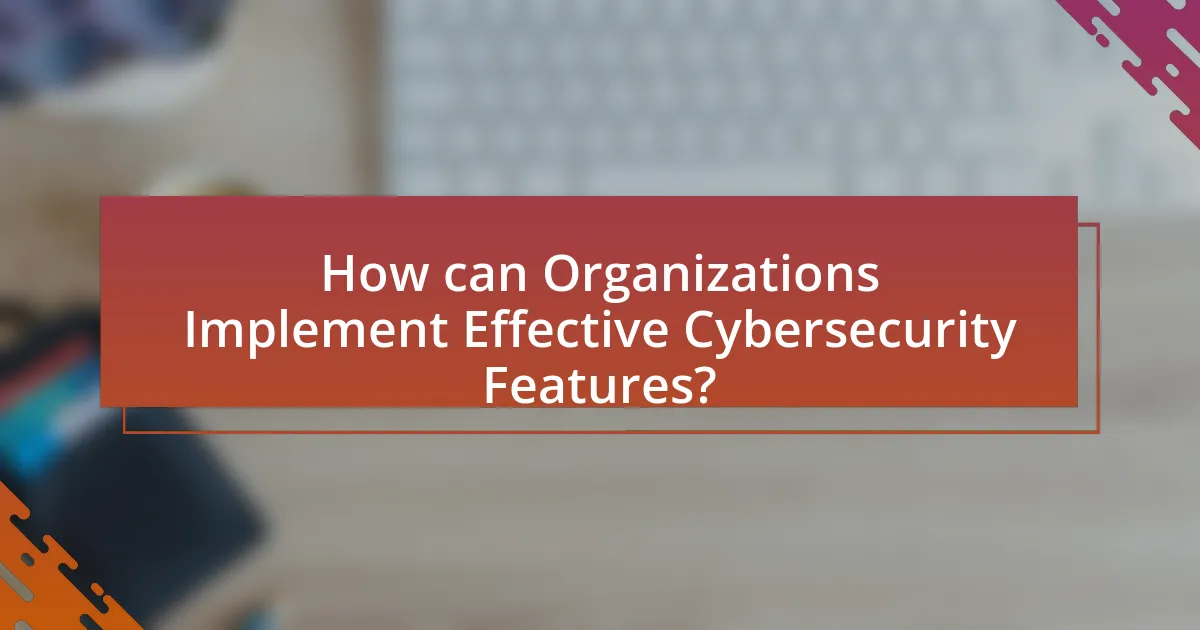The article focuses on essential cybersecurity features for modern applications, highlighting the importance of strong authentication mechanisms, data encryption, secure coding practices, regular security updates, and comprehensive logging and monitoring. It discusses how these features protect applications from various cyber threats, including malware, phishing attacks, and data breaches, while emphasizing the need for a multi-layered security approach. Additionally, the article outlines the potential consequences of neglecting cybersecurity, the role of encryption and authentication in securing applications, and practical steps organizations can take to enhance their security posture. Emerging trends such as artificial intelligence and zero-trust security models are also examined, providing insights into the future of application security.

What are the Essential Cybersecurity Features for Modern Applications?
The essential cybersecurity features for modern applications include strong authentication mechanisms, data encryption, secure coding practices, regular security updates, and comprehensive logging and monitoring. Strong authentication mechanisms, such as multi-factor authentication, significantly reduce unauthorized access risks, as evidenced by a 99.9% reduction in account compromise according to Microsoft. Data encryption protects sensitive information both in transit and at rest, ensuring confidentiality and integrity. Secure coding practices help prevent vulnerabilities like SQL injection and cross-site scripting, which are common attack vectors. Regular security updates address newly discovered vulnerabilities, with the National Vulnerability Database reporting thousands of vulnerabilities each year. Comprehensive logging and monitoring enable organizations to detect and respond to security incidents promptly, enhancing overall security posture.
How do these features protect applications from cyber threats?
These features protect applications from cyber threats by implementing multiple layers of security controls that detect, prevent, and respond to potential attacks. For instance, firewalls filter incoming and outgoing traffic based on predetermined security rules, while encryption safeguards sensitive data by making it unreadable to unauthorized users. Additionally, intrusion detection systems monitor network traffic for suspicious activity, allowing for real-time alerts and responses to potential breaches. According to a report by the Cybersecurity & Infrastructure Security Agency, organizations that employ a multi-layered security approach reduce the risk of successful cyber attacks by up to 80%.
What types of cyber threats do modern applications face?
Modern applications face various types of cyber threats, including malware, phishing attacks, denial-of-service (DoS) attacks, and data breaches. Malware can infiltrate applications through vulnerabilities, leading to unauthorized access and data theft. Phishing attacks target users to steal credentials, often exploiting application interfaces. Denial-of-service attacks overwhelm applications, rendering them unavailable to legitimate users. Data breaches occur when sensitive information is accessed or disclosed without authorization, often due to inadequate security measures. According to the 2023 Verizon Data Breach Investigations Report, 83% of breaches involved human elements, highlighting the importance of addressing these threats in application security.
How do cybersecurity features mitigate these threats?
Cybersecurity features mitigate threats by implementing protective measures that detect, prevent, and respond to cyber attacks. For instance, firewalls filter incoming and outgoing traffic to block unauthorized access, while intrusion detection systems monitor network activity for suspicious behavior. Additionally, encryption secures sensitive data by converting it into a format that is unreadable without the proper decryption key, thus protecting it from interception. According to the Cybersecurity & Infrastructure Security Agency, organizations that employ multi-factor authentication reduce the risk of unauthorized access by 99.9%. These features collectively enhance the security posture of applications, making them resilient against various cyber threats.
Why is it important to implement cybersecurity features in applications?
Implementing cybersecurity features in applications is crucial to protect sensitive data and maintain user trust. Cybersecurity features safeguard applications from threats such as data breaches, malware, and unauthorized access, which can lead to significant financial losses and reputational damage. For instance, a 2021 report by IBM found that the average cost of a data breach was $4.24 million, highlighting the financial implications of inadequate security measures. Furthermore, with increasing regulatory requirements, such as GDPR and CCPA, applications must incorporate cybersecurity features to ensure compliance and avoid hefty fines. Thus, the integration of robust cybersecurity measures is essential for the security, compliance, and overall integrity of applications.
What are the potential consequences of neglecting cybersecurity?
Neglecting cybersecurity can lead to severe consequences, including data breaches, financial losses, and reputational damage. Data breaches can expose sensitive information, affecting millions of individuals and organizations; for instance, the 2017 Equifax breach compromised the personal data of approximately 147 million people. Financial losses can be substantial, with the average cost of a data breach estimated at $4.24 million in 2021, according to IBM’s Cost of a Data Breach Report. Additionally, organizations may suffer reputational damage, resulting in lost customer trust and decreased market share, as seen in the aftermath of high-profile breaches like Target’s in 2013. These consequences highlight the critical importance of implementing robust cybersecurity measures.
How do cybersecurity features enhance user trust and engagement?
Cybersecurity features enhance user trust and engagement by providing a secure environment that protects personal data and fosters confidence in digital interactions. When users perceive that their information is safeguarded through measures such as encryption, multi-factor authentication, and regular security updates, they are more likely to engage with the application. Research indicates that 85% of users are more likely to trust a platform that demonstrates strong cybersecurity practices, as highlighted in a study by the Ponemon Institute, which found that organizations with robust security measures experience higher customer loyalty and satisfaction. This correlation between security and user engagement underscores the importance of implementing effective cybersecurity features in modern applications.

What are the Key Components of Cybersecurity Features?
The key components of cybersecurity features include risk assessment, access control, encryption, network security, and incident response. Risk assessment identifies vulnerabilities and threats to an organization’s assets, enabling the prioritization of security measures. Access control ensures that only authorized users can access sensitive information, often implemented through authentication mechanisms like passwords and biometrics. Encryption protects data by converting it into a secure format that can only be read by authorized parties, safeguarding information during transmission and storage. Network security involves measures to protect the integrity and usability of networks, including firewalls and intrusion detection systems. Incident response is the process of addressing and managing the aftermath of a security breach or attack, ensuring that organizations can recover quickly and minimize damage. These components collectively form a robust cybersecurity framework essential for protecting modern applications against evolving threats.
How does encryption contribute to application security?
Encryption enhances application security by protecting sensitive data from unauthorized access and breaches. It achieves this by converting plaintext information into ciphertext, making it unreadable to anyone without the appropriate decryption key. For instance, the use of Advanced Encryption Standard (AES) is widely recognized for its effectiveness in securing data in transit and at rest, as it employs a symmetric key algorithm that is difficult to crack. According to the National Institute of Standards and Technology (NIST), AES is a standard for encrypting sensitive but unclassified information, demonstrating its reliability in safeguarding application data. Thus, encryption is a critical component of application security, ensuring data confidentiality and integrity against cyber threats.
What types of encryption are commonly used in applications?
Commonly used types of encryption in applications include symmetric encryption, asymmetric encryption, and hashing. Symmetric encryption, such as AES (Advanced Encryption Standard), utilizes a single key for both encryption and decryption, making it efficient for large data sets. Asymmetric encryption, exemplified by RSA (Rivest-Shamir-Adleman), employs a pair of keys—public and private—for secure data transmission, enhancing security in scenarios like digital signatures. Hashing algorithms, including SHA-256 (Secure Hash Algorithm), convert data into fixed-size strings, ensuring data integrity by allowing verification without revealing the original data. These encryption methods are foundational in securing sensitive information across various applications, as evidenced by their widespread adoption in protocols like HTTPS and secure email communications.
How does encryption protect sensitive data?
Encryption protects sensitive data by converting it into a coded format that can only be read by authorized users with the correct decryption key. This process ensures that even if data is intercepted during transmission or accessed without permission, it remains unintelligible and secure. For instance, the Advanced Encryption Standard (AES) is widely used and recognized for its effectiveness, as it employs complex algorithms to secure data, making unauthorized access extremely difficult. According to the National Institute of Standards and Technology (NIST), encryption is a fundamental component of data protection strategies, significantly reducing the risk of data breaches and unauthorized disclosures.
What role does authentication play in securing applications?
Authentication is crucial in securing applications as it verifies the identity of users before granting access to sensitive data and functionalities. By implementing robust authentication mechanisms, such as multi-factor authentication, applications can significantly reduce the risk of unauthorized access. According to a report by Verizon, 81% of data breaches are linked to weak or stolen passwords, highlighting the importance of strong authentication practices in preventing security incidents.
What are the different methods of authentication?
The different methods of authentication include password-based authentication, multi-factor authentication (MFA), biometric authentication, token-based authentication, and certificate-based authentication. Password-based authentication relies on a user providing a secret password to gain access, while multi-factor authentication enhances security by requiring two or more verification methods, such as a password and a text message code. Biometric authentication uses unique biological traits, like fingerprints or facial recognition, to verify identity. Token-based authentication involves the use of a physical or digital token that generates a one-time code for access, and certificate-based authentication utilizes digital certificates to establish the identity of users or devices. Each method has its own strengths and weaknesses, making them suitable for different security needs in modern applications.
How can multi-factor authentication enhance security?
Multi-factor authentication enhances security by requiring users to provide two or more verification factors to gain access to a system. This method significantly reduces the risk of unauthorized access, as it combines something the user knows (like a password) with something the user has (like a smartphone app or hardware token) or something the user is (like biometric data). According to a study by the Cybersecurity & Infrastructure Security Agency, implementing multi-factor authentication can block up to 99.9% of automated attacks, demonstrating its effectiveness in protecting sensitive information and systems from breaches.

How can Organizations Implement Effective Cybersecurity Features?
Organizations can implement effective cybersecurity features by adopting a multi-layered security approach that includes risk assessment, employee training, and advanced technologies. Conducting regular risk assessments allows organizations to identify vulnerabilities and prioritize security measures accordingly. Employee training programs enhance awareness of cybersecurity threats, reducing the likelihood of human error, which is a significant factor in data breaches. Additionally, deploying advanced technologies such as firewalls, intrusion detection systems, and encryption can protect sensitive data and monitor for suspicious activities. According to the 2021 Verizon Data Breach Investigations Report, 85% of breaches involved a human element, underscoring the importance of training and awareness in a comprehensive cybersecurity strategy.
What best practices should organizations follow for implementation?
Organizations should follow a structured approach to implementation by prioritizing risk assessment, employee training, and continuous monitoring. Conducting a thorough risk assessment helps identify vulnerabilities and threats specific to the organization’s environment, enabling tailored security measures. Employee training is crucial, as studies show that human error accounts for a significant percentage of security breaches; therefore, educating staff on cybersecurity best practices can mitigate risks. Continuous monitoring ensures that security measures remain effective and can adapt to evolving threats, as evidenced by the increasing sophistication of cyberattacks. Implementing these best practices fosters a proactive security culture and enhances overall cybersecurity posture.
How can organizations assess their current cybersecurity posture?
Organizations can assess their current cybersecurity posture by conducting comprehensive security assessments, including vulnerability assessments, penetration testing, and security audits. These methods help identify weaknesses in systems and processes, allowing organizations to understand their risk exposure. For instance, a 2021 report by Cybersecurity & Infrastructure Security Agency (CISA) indicated that organizations that regularly perform vulnerability assessments reduce their risk of breaches by up to 30%. Additionally, leveraging frameworks such as the NIST Cybersecurity Framework provides a structured approach for evaluating and improving cybersecurity practices, ensuring alignment with industry standards.
What tools and technologies can assist in implementing cybersecurity features?
Tools and technologies that assist in implementing cybersecurity features include firewalls, intrusion detection systems (IDS), encryption software, and security information and event management (SIEM) systems. Firewalls act as barriers between trusted and untrusted networks, controlling incoming and outgoing traffic based on predetermined security rules. Intrusion detection systems monitor network traffic for suspicious activity and potential threats, providing alerts for further investigation. Encryption software secures sensitive data by converting it into a coded format that can only be read by authorized users, thus protecting information during transmission and storage. SIEM systems aggregate and analyze security data from across an organization’s IT infrastructure, enabling real-time monitoring and incident response. These tools collectively enhance the security posture of modern applications by mitigating risks and responding to threats effectively.
What common challenges do organizations face in implementing these features?
Organizations commonly face challenges such as resource constraints, lack of expertise, and integration issues when implementing essential cybersecurity features for modern applications. Resource constraints often manifest as limited budgets and insufficient personnel, which hinder the acquisition and deployment of necessary technologies. A lack of expertise can lead to ineffective implementation, as many organizations struggle to find skilled cybersecurity professionals who can navigate complex security landscapes. Integration issues arise when organizations attempt to incorporate new cybersecurity features into existing systems, often resulting in compatibility problems and operational disruptions. These challenges are supported by industry reports indicating that 60% of organizations cite budget limitations as a primary barrier to effective cybersecurity implementation, while 50% report difficulties in finding qualified personnel.
How can organizations overcome budget constraints for cybersecurity?
Organizations can overcome budget constraints for cybersecurity by prioritizing risk management and implementing cost-effective solutions. By conducting a thorough risk assessment, organizations can identify their most critical assets and vulnerabilities, allowing them to allocate resources more effectively. For instance, investing in open-source security tools can significantly reduce costs while still providing robust protection. Additionally, organizations can leverage cloud-based security services, which often operate on a subscription model, allowing for scalable spending based on actual needs. According to a report by Cybersecurity Ventures, businesses that adopt a proactive cybersecurity strategy can reduce potential breach costs by up to 50%. This demonstrates that strategic planning and resource allocation can effectively mitigate budget limitations while enhancing cybersecurity posture.
What strategies can be employed to ensure user compliance with security measures?
To ensure user compliance with security measures, organizations can implement strategies such as user education, clear communication of policies, and the use of incentives. User education programs that inform individuals about the importance of security measures and the potential consequences of non-compliance have been shown to increase adherence rates. For instance, a study by the Ponemon Institute found that organizations with comprehensive security awareness training saw a 70% reduction in security incidents. Clear communication of security policies, including regular updates and reminders, reinforces expectations and helps users understand their responsibilities. Additionally, offering incentives for compliance, such as recognition or rewards, can motivate users to adhere to security protocols. These strategies collectively enhance user engagement and compliance with security measures.
What are the Future Trends in Cybersecurity for Applications?
Future trends in cybersecurity for applications include the increased adoption of artificial intelligence and machine learning for threat detection, the implementation of zero-trust security models, and a focus on secure software development practices. AI and machine learning enhance the ability to identify and respond to threats in real-time, as evidenced by a report from Gartner indicating that by 2025, 75% of organizations will use AI for cybersecurity. The zero-trust model, which assumes that threats could be internal or external, is gaining traction as organizations seek to minimize risks; according to a study by Forrester, 70% of organizations are planning to adopt zero-trust principles by 2023. Additionally, secure software development practices, such as DevSecOps, are becoming essential as organizations aim to integrate security throughout the development lifecycle, with a report from the DevSecOps Community indicating that 80% of organizations are prioritizing security in their DevOps processes.
How is artificial intelligence shaping cybersecurity features?
Artificial intelligence is significantly enhancing cybersecurity features by enabling real-time threat detection and response. AI algorithms analyze vast amounts of data to identify patterns indicative of cyber threats, allowing for quicker identification of anomalies that may signify a breach. For instance, according to a report by McKinsey, organizations using AI for cybersecurity can reduce the time to detect and respond to incidents by up to 90%. Additionally, AI-driven systems can automate repetitive tasks, such as monitoring network traffic and managing alerts, which improves overall efficiency and reduces the likelihood of human error. This integration of AI into cybersecurity not only strengthens defenses but also adapts to evolving threats, making it a crucial component of modern cybersecurity strategies.
What emerging technologies are influencing application security?
Emerging technologies influencing application security include artificial intelligence (AI), machine learning (ML), and blockchain. AI and ML enhance threat detection and response capabilities by analyzing vast amounts of data to identify patterns indicative of security breaches. For instance, according to a report by Gartner, AI-driven security solutions can reduce incident response times by up to 90%. Blockchain technology contributes to application security by providing decentralized and tamper-proof transaction records, which can help prevent data breaches and fraud. A study published in the Journal of Cybersecurity highlights that blockchain can enhance data integrity and transparency, making it a valuable asset in securing applications.
What Practical Steps Can Organizations Take to Enhance Application Security?
Organizations can enhance application security by implementing a multi-layered security approach that includes secure coding practices, regular security assessments, and employee training. Secure coding practices involve following established guidelines such as the OWASP Top Ten, which identifies the most critical security risks to web applications. Regular security assessments, including penetration testing and vulnerability scanning, help identify and remediate security weaknesses before they can be exploited. Employee training on security awareness ensures that staff can recognize and respond to potential threats, reducing the likelihood of human error leading to security breaches. According to a report by the Ponemon Institute, organizations that invest in security awareness training can reduce the risk of a data breach by up to 70%.




